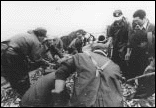|
|
|
|
青林舎作品 Production Company : Seirinsha |
| 長年、水俣に通いつつ「水俣」シリーズを製作し続けてきた土本典昭。1980年代にはこれまで蓄積してきた原子力に関する新聞記事に基づいた実験的短編『原発切抜帖』(1982)を製作、その後原子力問題を本格的なテーマにした。舞台は南の九州水俣からは遠く離れた本州の北端下北半島である。この半島は巨大開発と原子力船「むつ」の母港としてすでに原子力半島と化しつつあった。土本以下スタッフは漁師たちに焦点を当て、巨大企業集団のよる「海盗り」を主題にする。漁師の「海」に対する意識についてはすでに「水俣」シリーズでも徐々に描かれてきた視点である。しかし水俣での漁師たちはすでに歴然とした被害者であり、この下北半島の漁師たちは今後半永久的に被害者とならんとしているのである。1981年の浜関根。土本は漁師たちから丁寧な聴き取りを続け、一人芝居の役者と網元であるその家族など、それぞれの海に対する意識を明らかにしながら、米軍や自衛隊の演習地として、あるいは開発という名目で徐々に漁師たちから海を盗んでゆく科学技術庁、原子力船研究開発事業団、青森県などの手口を見せてゆく。しかし、漁民の分裂を利用した切り崩し工作や漁業権売り渡しの臨時総会でついに反対派は敗北し、原子力船「むつ」の新母港が着工される。後半、土本は空撮を含めてプルトニウム半島化しつつある下北半島の全体像にまで迫るのだ。 | For many years, Tsuchimoto Noriaki commuted to Minamata to produce the Minamata series. After producing an experimental short film called Nuclear Power Scrapbook ( " Genpatsu kirinukicho, " 1982) based on newspaper clips about nuclear energy, Tsuchimoto began to focus in on the nuclear energy issue as his main theme. The film takes place in Shimokita Peninsula on the north-ern edge of the mainland, far away from Minamata in southern Kyushu. Shimokita was becoming a " nuclear energy peninsula, " undergo-ing tremendous development and serving as the home port for Mutsu, a nuclear-powered ship. Focusing on fishermen, Tsuchimoto and his crew make their subject matter the " robbing of the sea " perpetrated by giant business conglomerates. Tsuchimoto used the perspective of the fisher-men's perceptions of the " ocean " extensively in the Minamata series. While the fishermen of Minamata are obviously victims however, the fish-ermen in Shimokita Peninsula are still in the pro-cess of becoming semi-permanent victims. Hamasekine in 1981. Tsuchimoto conducts careful interviews of the fishermen, a one-man stage play actor and his boat-owner family, elucidating their perceptions of the ocean. Through these inter-views, this film shows how the Science and Technology Agency, the Japan Nuclear Ship Research and Development Agency, and the Aomori Prefectural Government gradually steal the sea from the fishermen to turn it into a train-ing site for the US military and the Japanese Self Defense Forces, in the name of development. The opponents of the " theft " failed in the face of an effort to divide the fishing community and at an extraordinary general meeting to sell fishing rights, and in the end, the construction of a new home port for Mutsu went forward. In the last half of the film, Tsuchimoto uses aerial photography to capture the whole of Shimokita Peninsula as it is transformed into a " plutonium peninsula " . |

